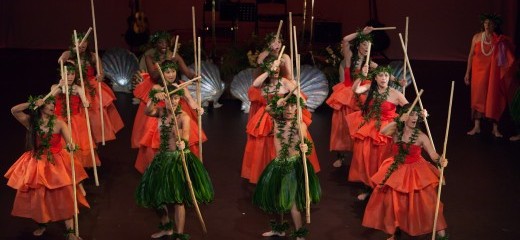
Photo: Wayne Takenaka
Pua, Politics, and Tap
By Lynn Matluck Brooks
The crowd at the Asian Arts Initiative was treated to a surprising juxtaposition of elements on Wednesday evening, March 20. The mixture of lecture and performance, hula and tap, traditional and new forms was delightful, informative, and puzzling all at once. The occasion was the performance of the
Pua Ali’i ‘Ilima (The Royal ‘Ilima Blossom) Hawaiian dance group, the capstone to several days of community workshops for children and adults. The Honolulu-based company, led by Vicky Takamine, featured dancers Ka’iulani Takamori and Charlene Hazlewood, with drummer-singer-dancer-choreographer Jeffrey Takamine. Also on the program was master violinist Diane Monroe and accomplished singer-dancer Germaine Ingram. The thread intended to hold the evening together was “Performance at the Intersection of Performance and Social Change” (the redundancy was in the program listing), the subject of a post-show conversation among Ingram, Vicky Takamine, and Jeffrey, Vicky’s son.
The evening began with Ms. Takamine, a Kumu Hula (hula master), explaining her family’s royal Hawaiian lineage, the cultural decimation that deprived Hawaiians of language, rituals, and dance, and her impulses to take political action in defense of cherished traditions. Then, as Jeffrey Takamine, also a Kumu Hula, chanted sacred poems and drummed the
pahu, Takamori and Hazlewood, dressed in simple white cotton dresses with brilliant blue overskirts, performed a series of sacred dances reconstructed in what Takamine believes, through her research, to be traditional style. The dancers’ unison arm movements were fluid, gentle, and expressive with hand gestures that suggested the shiver of rain, mountain peaks, ocean vistas, bright skies, net-fishing, greeting those nearby and those far off. Later in this set, the dancers’ hands lightly addressed their eyes, mouths, and ears, as if engaging all senses in the expression of the chant supporting them. Soft paddling steps kept the dancers’ hips swaying elegantly. For the final dance, the ladies picked up feathered
’uli -’uli rattles, adding to the music of drums and voice.
The middle portion of the evening began with Monroe on stage, playing violin as images of sun-drenched street signs bearing names like “Success,” “New Life,” and “Old Life” flashed across the backdrop. Ingram rose from among the audience members to join Monroe on stage. Singing “The Sunny Side of the Street” in a subdued and parsed fashion, Ingram deliciously layered her footwork—taps, slides, and drags—over and under the violin pizzicato and melody. From the flow of Ingram’s torso, arms, and head, and from the audible footwork, I could tell her tapping was rich and interesting, but the poor sightlines in the narrow, packed space made it impossible to see her feet if you were anywhere but the front row. Nonetheless, it was still worth seeing and hearing these two sharing a language that they controlled with consummate freedom.
Ms. Takamine spoke again to introduce the evening’s third part: contemporary interpretations of hula, shaped by instruments that non-Hawaiians brought to the island, and by the strophic and melodic hymns that missionaries taught. The music for this set was recorded—piano, voice, ukulele and guitar—and now Jeffrey—grass-skirted and, like the two ladies, leaf-crowned—joined them. The movement struck me as similar to what we had seen earlier (indeed, the first dance in this set was, I believe, identical to a dance that opened the show), but the pace was faster, the facial expressions brighter, as if focused more on people in the audience than on gods in the vast skies and oceans that grace the Hawaiian islands. Gestures alluded to smelling a flower, following waves, opening the heart. For the final dance, each performer clasped a set of
‘ili-’ili stones (we later learned these were carefully selected from along the ocean shores), which they played like castanets, adding vibrancy to the lively circling, reaching, turning, and rocking motions of the dancers. Their faces positively gleamed.
The performing over, Ingram led the Takamines in a series of questions about their understandings of cultural heritage, of hula’s gendered performance styles, and—particularly for Vicky—the family’s engagement in political action in defense of that heritage. Ingram’s own danced contribution to the evening was not addressed in that discussion and seemed an untethered, if delightful, add-on, its intersections with political action never clarified further than the rather humorous road signs in the photos that flashed behind Ingram’s dancing.
Pua Ali’i ‘Ilima at the Asian Arts Initiative, March 20, 2013.
By Lynn Matluck Brooks
March 25, 2013

